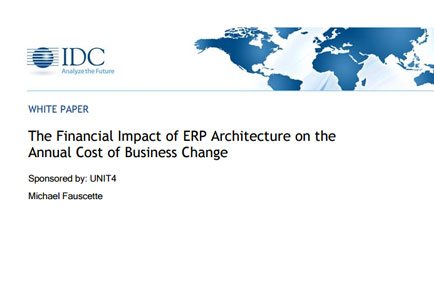
PROCESSING. PLEASE WAIT...

White Paper: IDC
ERP systems are the technology backbone of the modern business, and as such, the process of matching the "right" system to specific business needs is extremely critical. Most companies spend quite a bit of scarce resources (time and money) on defining the business requirements and then evaluating the potential systems for a close functional fit and for the potential up-front (implementation and license) costs.

By: BPM Partners
How does a hybrid approach to performance management disrupt conventional solutions while preserving the value of spreadsheets? The hybrid approach to performance management is basically a design approach that combines a centralized database, workflow, and protective governance of spreadsheets for both input and output vehicles. This whitepaper examines the tradeoffs of the relatively new hybrid approach, and how it wraps data governance around the spreadsheet as an input vehicle. In this whitepaper, you’ll get to know more about: How spreadsheet-based performance management provides a competitive advantage, extends performance management into other application areas, and lowers risk How hybrid solution imposes workflow on data collection and the protection of audit capabilities around budgets and report numbers that export to a spreadsheet for analysis and usage The benefits of mixing Excel spreadsheets with key aspects of packaged applications for business performance management
By: Business Automation
How to prepare for an ERP and how to successfully implement an ERP system? Enterprise resource planning (ERP) system has been one of the most popular business management solutions, providing benefits of real-time capabilities and seamless communication for business in large organizations. However, not all ERP implementations have been successful. One of the top reasons ERP implementations fail is because the software doesn’t meet basic industry specific business requirements. However, purchasing an ERP application is only half the battle. A well designed ERP implementation plan is the key to success. The kinds of helpful information outlined in this informative Enterprise resource planning (ERP) whitepaper you will find within include: How to choose an ERP system that aligns with your company’s specific business requirements? A step by step guide to implementing ERP software, beginning with project organization, and taking you all the way through discovery, implementation, testing, configuration and training. As an added bonus, you will also get to know about some common risks that arise during the ERP implementation process and recommendations for managing them. Implementing an ERP system is not straightforward, but remembering some of these simple suggestions will help your project have a greater chance of success than ignoring them.


 2025 All Rights Reserved | by: www.ciowhitepapersreview.com
2025 All Rights Reserved | by: www.ciowhitepapersreview.com